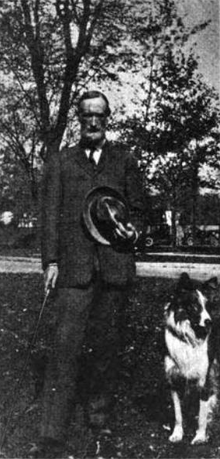William Herbert Hobbs
This article needs additional citations for verification. (March 2015) |

William Herbert Hobbs, Ph.D. (Worcester, Mass., July 2, 1864 – Ann Arbor, MI, January 1, 1953) was an American geologist.
Background and education[]
William Herbert Hobbs, geologist and leader of four expeditions to Greenland, was born in Worcester, Massachusetts, July 2, 1864, the son of Horace and Mary Paine (Parker) Hobbs. He was educated at Worcester Polytechnic Institute (in 1883 he was graduated with the degree of Bachelor of Science.), at Johns Hopkins (Ph.D., 1888), and at Heidelberg (1888–89).[1]
Career[]
He filled several positions at the University of Wisconsin–Madison (1889–1906). From 1886 to 1906 he served with the United States Geological Survey. He received his appointment as Professor of Geology, Aug. 6, 1906. He also taught at the University of Michigan (1906 - 1934).[2]
Professional and scientific organizations to which Hobbs has been elected to membership or to office are the following:
- Fellow, Geological Society of America (1892);
- Phi Beta Kappa Society (1902);
- Seismological Committee of the American Association for the Advancement of Science (1907);
- Wisconsin Academy of Sciences, Arts and Letters (life member, 1892);
- Fellow, American Philosophical Society (1909);
- vice-president, (1917), president (1935), Association of American Geographers;
- member, Washington Academy of Sciences, Arts and Letters (1914);
- vice-president for geology and mineralogy, Michigan Academy of Science (1907);
- president, Michigan Academy of Sciences, Arts and Letters (1916);
- honorary member, Veterans of Foreign Wars (1920);
- Fellow, American Meteorological Society (1929);
- first vice-president, Geological Society of America, (1922);
- Chevalier of the Legion of Honor (France) (1924);
- Council of American Philosophical Society (1929–32);
- Honorary Degree, Doctor of Engineering, Worcester Polytechnic Institute (1929);
- member, Explorers Club, New York (1930);
- vice-president, International Glacier Commission (1930–34);
- vice-president, American Association for the Advancement of Science (1933);
- Fellow, American Geographic Society (1933);
- honorary member, Russian Geographical Society (in Leningrad) (1934);
- Fellow, Geographic Society of Chicago (1937);
- Honorary Degree, Doctor of Laws, University of Michigan (1939);
- emeritus life membership, American Association for the Advancement of Science (1939).
He became editor of the Journal of Geology in 1909.
Personal[]
On June 23, 1896, he was married at Evanston, Illinois, to Mrs. Sara Kimball Sale, who died in 1940. They had one daughter, Winifred Sara Weston Hobbs, (b. 1899) who later became Mrs. Joseph Newhall Lincoln.
He died in Ann Arbor, MI on January 1, 1953, at the age of 88.[3]
Bibliography[]
- Earthquakes: An Introduction to Seismic Geology (1907)
- Characteristics of Existing Glaciers (1911)
- Earth Features and their Meaning (1912).
- The World War and Its Consequences (1919)
- An Explorer-Scientist's Pilgrimage: the Autobiography of William Herbert Hobbs (1952).
References[]
External links[]
- Newspaper clippings about William Herbert Hobbs in the 20th Century Press Archives of the ZBW
- The Papers of William H. Hobbs at Dartmouth College Library
- William Herbert Hobbs Papers at Bentley Historical Library, University of Michigan
- 1864 births
- 1952 deaths
- American geologists
- American non-fiction writers
- Worcester Polytechnic Institute alumni
- Johns Hopkins University alumni
- People from Worcester, Massachusetts
- University of Michigan faculty
- Presidents of the American Association of Geographers
- American polar explorers
- American geologist stubs